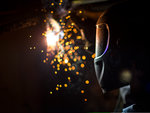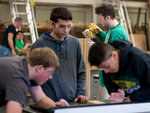


Students at Centralia High School have a numbrt of opportunities to put their skills to the test and learn more about careers, post-high school education and training options through the district’s career and technical education program.
From raising farm animals in a barn at the high school, to learning more about welding and sports medicine, the classes vary greatly.
All of the classes have one common purpose — to help prepare students for life after graduation.
The district’s school board took a tour of the CTE classes on Wednesday, prior to its monthly school board meeting. Students and teachers spoke about the opportunities the classes provide students, including earning college credits through the program.
Gabriela Robles, a sophomore in the sports medicine program, said the classes have readied her for higher education.
“It helped me be prepared for what I’m expected to do in college,” she said.
Robles hopes to become an orthopedic surgeon.
The sports medicine program, like many other CTE classes, has grown. In 2009, there was one sports medicine class and now it has expanded to offer five courses.
As for one of the manufacturing technology courses, Brian Taylor teaches students welding. During the first semester of the year, 80 students went through the program. Four went on to compete at the Regional Skills USA Competition, while three competed at the Lower Columbia College Welding Competition.
James Bowers, CTE director for the district, said welding is a high-demand industry.
“It’s crazy what’s going on in this industry,” he said. “It’s an industry that’s only growing.” Students are able to walk out of the classes and go on to careers with a starting wage between $40,000 and $60,000 on average, he said. Over 30 college articulations are available through the metals and welding program.
Other students can earn college credits in photography and videography, and are able to obtain numerous certifications through the business education courses.
Other courses in the program focus on agriculture, construction and wood arts, family education, consumer sciences for both the high school and the middle school, and STEM-based courses, such as robotics.
Mark Davalos, superintendent of the district, said the CTE program illustrates project-based learning, which gives students the skills they need for college or post-high school careers.
“We want all the education to be at the highest level of education for the kids,” Davalos said. “… I think that’s why these programs are so relevant and need to be maintained and supported and grown.”
Bowers said 66 percent of the American workforce does not have a bachelor's degree — yet.
“All those programs support bachelor degree programs in every way, shape and form,” he said. “Whatever the case is, it will prepare a student for anything they want to do in CTE.”
The CTE program is funded in part by $13,000 in levy funds and $29,200 in funds provided through the Perkins Grant.
“I’m thankful we have the levy dollars that we get and the Perkins money also,” Bowers told the school board. “That helps to cover our costs after we use the levy dollars for equipment, then the Perkins money is spent on what we call professional development in CTE.”
The professional development ensures teachers are current on the industry.
Levy money has been used to purchase new stoves and food storage bins for the family and consumer sciences education program; ladders, tool replacement and tool guards for the welding program; as well as the replacement of greenhouse cooling pads and a greenhouse roof repair for the agriculture program.
The program also heavily relies on grants. The agricultural sciences program recently received a $500 grant to build a fence around a vegetable garden the students have started, and $10,000 has come from the GRADS iGrant program.
For more information on the CTE courses, go online to the district’s website www.centralia.k12.wa.us.